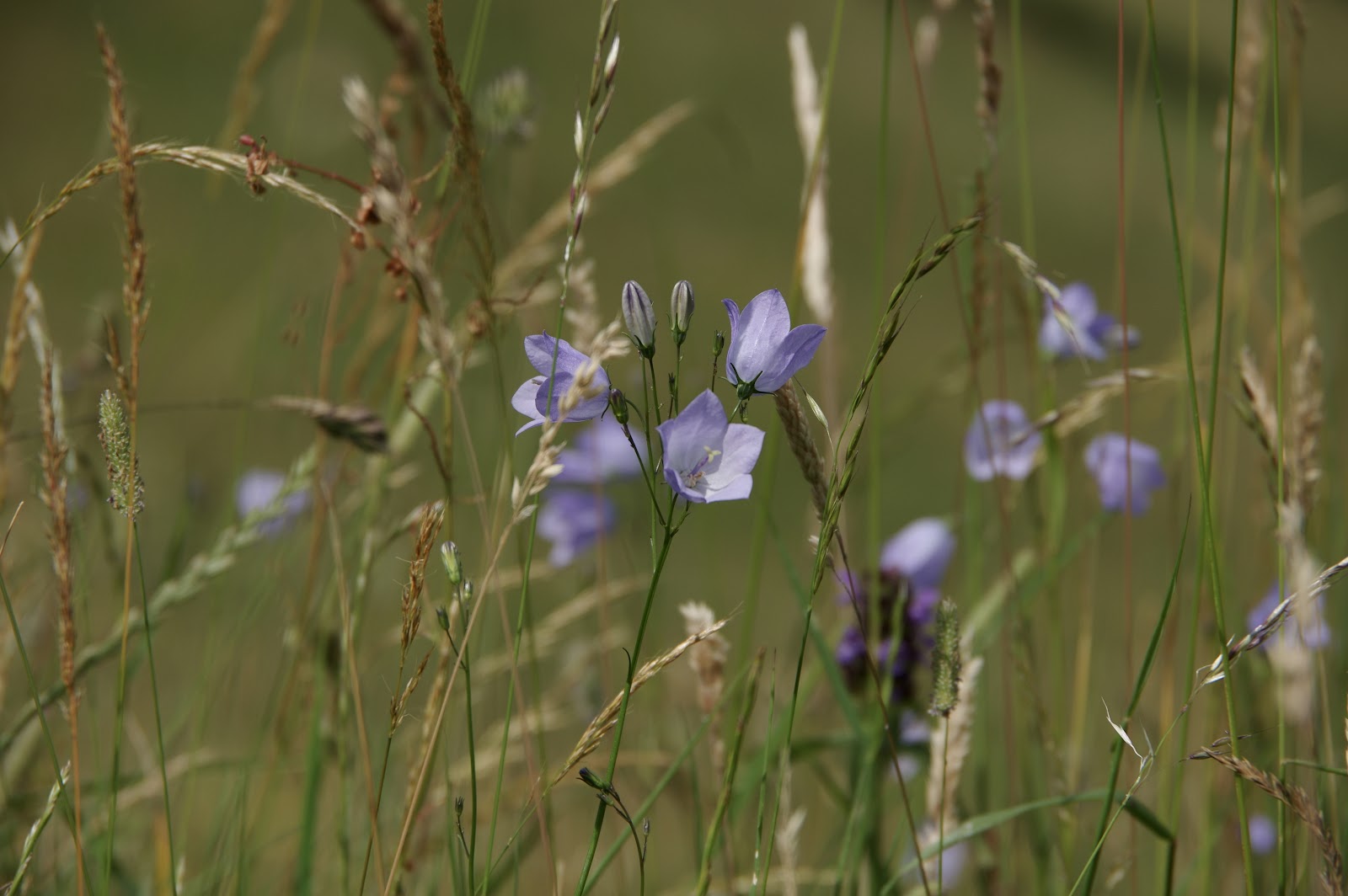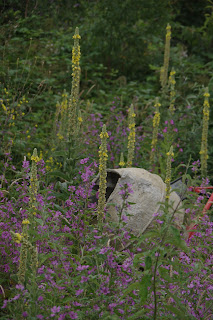Wild Marjoram (Origanum vulgare) in its natural habitat- grassland on calcerous soil. Close relative of Pot Marjoram (Origanum onites) and various other Oreganos- Greek, Cretan etc.
A diary of back garden botany, urban ecology, rural rambles and field trips to the middle of nowhere...
Tuesday, 30 July 2024
Friday, 26 July 2024
Wednesday, 24 July 2024
'Blowsy' is not really a quality I admire in flowers. Nonetheless the double flowered form of Soapwort (Saponaria officinalis) is what you might call blowsy (in a good way). And it's a plant with a purpose. Rubbing the leaves with water lathers up to produce a thin detergent which was used among other things for cleaning wool and fabric.
Rarely planted these days. These are at the music school which was originally a country villa built for the botanical pharmacist William Ransom in the nineteenth century. Perhaps the remnant of a practical usage? They grow next to an outbuilding which has the look of a washhouse/laundry.
Monday, 22 July 2024
A swathe of Field Scabious (Knautia arvensis) on the Pegsdon Hills.
I include this rather out of focus image so I can tell the story of this fascinating critter- the Brassy Longhorn Moth (Nemphora metallica). Those 'horns' are actually antennae. Field and Small Scabious are its larval food plant.
Moreover plant and insect have a symbiotic relationship with a parasitoid wasp Stilbops ruficornis which lays its eggs among or near the eggs of the moth. The moth needs the plant, the wasp needs the moth and the plant needs the wasp. The wasp larvae feed on the moth caterpillars keeping their numbers in check which helps the plant to survive.
Sunday, 21 July 2024
Only a mile or two separates them but the Pegsdon Hills and Oughtonhead Common have a very different flora. The hills are grasslands on free-draining chalk. The common is marshland on a pocket of boulder clay. Here the waters from the hills feed the springs which bubble up at the head of the River Oughton.
Hemp Agrimony (Eupatorium cannabinum) is much in evidence along with other species that need a damp habitat: Meadowsweet, Purple Loosestrife, Marsh Orchid et al. To quote Brian Sawford: "Marshes fed with highly calcerous waters can support a great variety of wildflowers."
Thursday, 18 July 2024
Wednesday, 17 July 2024
Tuesday, 16 July 2024
This enormous pig of some rare breed reminds me of a story my father told me. I was a toddler when this incident occurred, too young to remember it in fact.
At that time there was still a livestock market in the centre of Hitchin, my home town. It took place on Tuesdays along with the main fruit and veg market. Buses came in from the local villages and the pubs were allowed to stay open in the afternoon rather than closing at three to reopen at six. Market day was quite a big deal back then.
On one occasion my father and I were in the yard where livestock was bought and sold. Suddenly a big pig got loose and came running towards us. My father snatched me up in his arms and stood to one side as the pig charged past. In pursuit came an irate farmer who shouted at my father "You bloody idiot why didn't you stop it?"
Sunday, 14 July 2024
These tall plants are Hemlock (Conium maculatum) I believe. As mentioned in my last entry the Umbellifer family includes some very toxic species, Hemlock among them. All parts of the plant are poisonous if consumed and can be a severe irritant to skin/flesh/eyes if handled.
I heard on the radio recently that Hemlock has grown high and mighty this year as a result of the wet weather (so have a lot of plants). A row of them lined a footpath I walked along last week and they were a good eight or nine feet in height.
The purple specks and blotches on the stems are characteristic of C. maculatum.
Friday, 12 July 2024
I think the yellow Umbellifer is Wild Parsnip (Pastinaca sativa), if so the precursor of our cultivated vegetable. Having said that I'm always a bit wary of identifying plants of the Umbelliferae aka Apicaceae family. Some are edible but it includes a selection of very toxic species- foragers beware! Indeed the sap of Wild Parsnip is reported to cause severe blistering by making the skin highly sensitive to sunlight, a condition known as phytophotodermatitis.
I'm pretty sure this is the mystery plant that has infested several of the borders at the music school this year. We assumed we were looking the first year's growth of a biennial and the leaves seem to correspond to P. sativa in full flower. I'm bound to say I weeded a good many by hand not always wearing gloves with no ill effects. Perhaps the young plants aren't sufficiently sappy? We are mystified how it arrived in such numbers. No doubt it is a prolific self-seeder but from where?
In an herbaceous/mixed border we class it is a weed but it is attractive in the wild. And a big draw for flies and Red Soldier Beetles...
Wednesday, 10 July 2024
This has been a bad year for bees and butterflies as far as I can tell from my wanderings in Hertfordshire. The ubiquitous Garden Bumblebee and the widespread Meadow Brown seem to be the only species holding up reasonably well. I'm starting to see more bees on the wing e.g. Common Carder as seen above. Also a few other butterfly species - Comma, Marbled White, Red Admiral etc. but not in numbers, just the occasional sighting.
Presumably the wet winter and the cool, damp spring into summer has hammered them. Ironically it's been a year of rampant growth for wildflowers and garden plants so the food sources are there; less so the pollinators to forage on them.
Tuesday, 9 July 2024
Gazing across that corn field at the blue hues of Echium [last entry] my eye was drawn to another plant dotted here and there. Its flowers were vivid magenta/purple. That colouration does not really feature in the palette of UK wildflowers. When I got close to one I realised it was a Mallow. Our Common Mallow (Malva sylvestris) is very common indeed but it has pink flowers.
I surmise this is Malva sylvestris ssp. mauritiana which is native to parts of Southern Europe and North Africa (sometimes said to be a variety rather than a subspecies). It strengthens my guess that this field was sown with a wildflower mix which for some reason wasn't quite native. As noted the Echiums are the non-native annual rather than our native biennial. Instead of Common Mallow we have have the uncommon mauritiana.
NB query for the botanical Latinists. The annual and biennial Echiums are both referred to as E. vulgare though they are notably different from each other. M. sylvestris has the distinction between species and subspecies/variety; surely the same could be said of the Echiums? Are they even the same species?
The categorisation of species or ssp. or var. or cultivar seems to be moot in certain cases. Anyway, plants are what they are whereas botany was invented by humans!
Monday, 8 July 2024
I was intrigued to see drifts of blue flowers of a species unknown to me in a large cornfield earlier today. For one thing the field has not been sprayed which is unusual. There were also a good many Ox-eye Daisies, Poppies and other 'arable weeds' which would not have survived being doused in herbicides.
These are native wildflowers but what could that haze of blue be? On closer inspection I think it's Echium vulgare. The bristly biennial Viper's Bugloss is another one of our native species but this appears to be the annual Echium 'Blue Bedder' which is not native. Confusingly the two distinctly different plants are both referred to as Echium vulgare and as Viper's Bugloss. Common names often overlap but the point of botanical Latin is to differentiate between species.
I reckon this area was sown with wildflower seed as a set-aside scheme and the mix included the non-native E. vulgare, whether by accident or design I cannot say. I gather it's just as popular with bees and it obviously grows well at this location.
Wednesday, 3 July 2024
The "urban flower meadow" in my last entry is really no such thing. Rather it is a small patch of waste ground colonised by wildflower/weeds, notably various 'pioneer' species that spread quickly on bare and disturbed soils.
There is however a fashion for creating urban meadows. A nice idea but sometimes disappointing in practice as seen above. Several large areas of this parkland were scalped of grass and seeded with wildflower species last autumn. [see entry dated 2nd. November 2023]
As of last week not much to see. The grass (probably a rye grass) recovered rapidly and the seed did not take. It can be done, as seen here at the music school:
Ox-eye Daisy was in full flower a couple of weeks ago when this photo was taken. Greater Knapweed is growing strongly at the moment. It's not possible to recreate the delicate balance of an ancient turf but vigorous species like these can prosper and multiply.
I suspect the success of this new meadow is that it was seeded into an area that had been an old lawn that itself had meadow characteristics. For one thing our ancient meadows do not contain rye grass which is a very effective ground cover.
It is ironic that derelict land generally becomes a cornucopia of wild flowers whereas planned meadows often do not.
Subscribe to:
Comments (Atom)




































